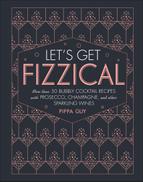HOW DO THEY MAKE IT BUBBLY?
THE “SPARKLE” IN FIZZY WINES is caused by carbon dioxide, a natural by-product of fermentation. Any fizz produced in winemaking is usually let loose to create still white or red wine, but some wines taste better with bubbles. To capture the sparkle, winemakers must stage an intervention, trapping and enhancing the bubbles in a tightly sealed bottle or tank.
FERMENTATION

AS THE SUGAR is consumed by the yeast, alcohol is produced, along with carbon dioxide. The result is a dry (low-sugar) base wine.
Sugar
This comes from the juice of the grapes. The grapes also contain acids and tannins (a bitter compound), which add to the flavor.
Yeast
Yeasts (microscopic organisms) occur naturally on grape skins, although they are often introduced artificially for better results.
Alcohol
The sugar is eaten by the yeast and converted into alcohol. Heat, aromas, and carbon dioxide are also produced.
THE TRADITIONAL METHOD
PIONEERED IN CHAMPAGNE, this is the original way of making fizz and a marker of premium wine. It is a legal requirement that all Champagne is made via this method. It is a time-consuming, laborious, and expensive process, but it produces great results. Secondary fermentation occurs inside each individual bottle.
1. Base wine

A still base wine is made. This is fermented dry (with low sugar), often using underripe grapes.
2. Bottle and sweeten

With the addition of a little more sugar and yeast, the bottles of base wine are tightly sealed.
3. Secondary fermentation

This creates more carbon dioxide in the sealed bottle, carbonating the wine.
4. Autolysis (aging)

The lees (dead yeast particles) are left in the bottle for months or even years. Contact with the lees creates complexity.
5. Disgorging

After aging, the lees will have risen to the neck of the bottle. They are frozen so they can be easily removed as a block of ice.
6. Dosage

Before the wine is resealed, sugar (dosage) is added. The amount of sugar depends on the desired level of sweetness.
THE TANK METHOD
MANY FIZZY WINES are now made via less time-consuming methods. In the “tank method,” the aging stage is skipped because the wines are intended to be fresh and young. As the name suggests, the bubbles are created in a pressurized tank rather than in the bottle. The advantage of this method is that the wine can be produced in bulk. It is faster and more economical than the “traditional method.”
